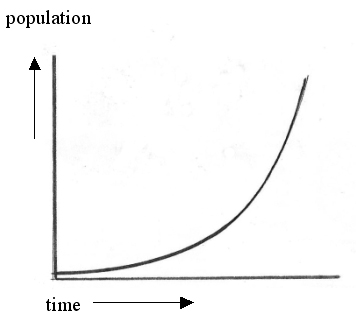Chapter 29. Populations
Page 259
1. It takes about 8 days for the mortality rate to equal the replacement rate.
2. a Approximately 8 per unit volume.
b About 992 per unit volume.
c There is no increase.
Page 261
1. The population increases from about 30 to about 80,000 over a period of 2.5 days, so the average rate of increase (ignoring the 30) is 80,000/ 2.5 = 32,000 per day.
2. Depending on the scales you chose, the graph should look something like this (with the kinks smoothed out).
 |
It broadly fits the first two sections of the sigmoid curve (lag phase and exponential phase). There is likely to be a continued increase in the growth rate until the pheasant population reaches equilibrium with its resources. |
3. Since the scale is linear and not logarithmic, the increase in population of Paramecium aurelia does not strictly show a pattern of exponential growth. However there is a lag phase for the first two days and a steady state by day 15 with the most rapid growth from days 3 to 8.
4. There will be competition for food, mates and nest sites. These factors and the presence of predators will limit the population.
5. a Abiotic factors. Availability of nest sites; exposure to weather (e.g. mountainous conditions, strong winds and low temperatures).
b Biotic factors. Availability of food, presence of predators, availability of nesting materials, spread of disease.
Page 264
1. a The ‘baby boom’ occurred between about 1948-50.
b The birth rate was about 38 per thousand but the death rate was about 28 per thousand,
so the growth rate was about 10 per thousand.
2. Heart disease and strokes affect mainly people beyond child-bearing age. Measles affects mainly people below child-bearing age. The effects of the remaining diseases depend very much on the countries involved but smallpox is very infectious and spreads rapidly throughout a population compared with polio and tuberculosis and seems to most likely to affects growth rate.
3. The death rate in poor countries is high compared with wealthy countries. The birth rate remains high in order to maintain family size and provide more ‘bread-winners’. As countries grow richer and more industrialized smaller numbers are needed to support the family. In wealthy countries the people are usually better educated and informed about the methods of birth control. This means they can limit their families and improve their life style. Child bearing can be postponed while young people improve their education.
4. A growing population needs more land to build homes and extend food-growing areas. It makes increasing demands on water and other natural resources including minerals, hydrocarbon fuels, building-materials and timber.
The environment is damaged when habitats are destroyed to make way for buildings and farms. A growing population is likely to depend on an increasing degree of industrialization with all the risks of pollution and consequent environmental damage.
5. 12,000 live births in a population of 400,000 is a birth rate of 12,000/4000 = 30 per thousand.
6. If couples had only 2 children and one of them died before child-bearing age, the population would diminish.
7. a In Figure 29.8 (a) male babies outnumber females by about 270 vs 220 millions. In population (b) female babies slightly outnumber male babies.
b Between the ages of 20 and 40 the numbers are roughly the same with a slight preponderance of men, particularly in population (a)
c In the over-70s the male population has diminished faster than the female population in both cases.
8. Reduction in the incidence of diphtheria was probably due to improvements in living standards including nutrition which would increase resistance to disease and less overcrowding which would reduce the chances of cross infection. |
Downloads
Download the answers in PDF format below
Section 1, Chapters 1-5
Section 2, Chapters 6-9
Section 3, Chapters 10-12
Section 3, Chapters 13-17
Section 3, Chapters 18-20
Section 4, Chapters 21-24
Section 5, Chapters 25-27
Section 5, Chapters 28-29
Section 6, Chapters 30-34
Section 6, Chapters 35-37
Section 7, Chapters 38-39
Section 8, Chapters 40-41
|

